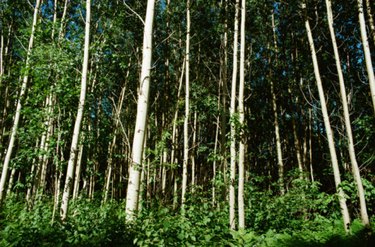
Aphids, tiny insects that feed on the leaves and stems of plants, attack many types of trees, including aspens. When you see a large number of aphids on your aspen tree, you need to take action to deal with the problem. Aphids can cause the leaves to yellow and leave the tree vulnerable to the sooty mold fungus. Fortunately, good remedies exist for aphid control.
Neem Oil
Video of the Day
Neem oil is an organic pesticide made from the neem tree, a native of India and Southeast Asia. The primary ingredient in neem oil, azadirachin, is extracted from the tree's seed. Neem oil interferes with the aphid's mating habits, reducing the overall population. It is an environmentally friendly product that degrades when exposed to rainfall and ultraviolet light. Because neem oil is more easily dispersed than chemical pesticides, you may need to give your tree more than one application.
Video of the Day
Homemade
Avoid commercial pesticides by making a home remedy recommended by Oregon State University Extension. Mix 1 cup water, 1 tsp. vegetable oil and 1 tsp. dishwashing liquid. Spray this solution onto the aspen tree with a hose. Make sure you wet the underside of the leaves, which is where aphids often collect. Leave the solution on the tree for a few hours, then wash it off with water. If the solution is not rinsed off, it can damage the leaves.
Ladybugs
Ladybugs, or lady beetles, are the natural enemies of a number of insects, particularly aphids. A single ladybug can eat as many as 5,000 aphids during its lifespan. Gardeners who favor biological aphid control can buy ladybugs at garden centers or online. This natural control method is especially useful to farmers, since a large population of aphids on their crops can reduce the overall harvest.